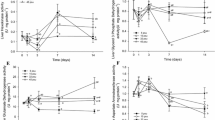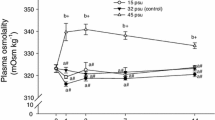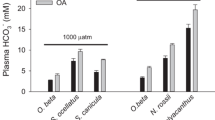Abstract
Free amino acids (FAAs) are believed to play important roles in osmoregulation and buffer capacity in some aquatic animals, such as fishes. However, the potential roles of FAAs have not been systematically summarized and characterized until now. In the present study, the meta-analysis was conducted to investigate the relationships between FAAs and environmental salinities. Twenty published documents were included, accounting for 106 study cases. The effect sizes of total free amino acids (TFAAs), total essential amino acids (TEAAs), and total non-essential amino acids (TNEAAs) to salinity increase were calculated and determined by the restricted maximum likelihood (REML) method. It clearly showed that the elevated salinities significantly induced the contents of TFAAs, TEAAs, and TNEAAs at the ratio of 36%, 27%, and 29%, respectively. Faced to the salinity changes, the contents of FAAs in fishes under freshwater and seawater varied significantly, while the individuals under brackish water displayed relatively constant contents of FAAs. When salinity elevated, the contents of 17 amino acids in muscles significantly increased, suggesting the important roles of FAA metabolism in osmoregulation in fishes. The results also indicated that the effect sizes of TFAAs were positively related to the rates of salinity increases, and exhibited a significant quadratic linear relationship with temperatures. Additionally, the contents of FAAs also showed positive correlation with osmotic pressure, concentrations of plasma Na+, Cl−, and urea, implying their potential roles of FAAs in osmoregulation in fishes. These findings suggested that elevated salinities greatly induced the contents of FAAs in fishes, making a great contribution to maintaining the homeostasis of fishes in response to environmental salinity changes.







Similar content being viewed by others
Data availability
Dataset generated in the current study was uploaded as supplementary files.
Code availability
Code are available from the corresponding author on reasonable request.
References
Ahokas RA, Sorg G (1977) The effect of salinity and temperature on intracellular osmoregulation and muscle free amino acids in Fundulus diaphanus. Comp Biochem Physiol A Physiol 56(1):101–105. https://doi.org/10.1016/0300-9629(77)90448-0
Aragao C, Costas B, Vargas-Chacoff L, Ruiz-Jarabo I, Dinis MT, Mancera JM, Conceicao LEC (2010) Changes in plasma amino acid levels in a euryhaline fish exposed to different environmental salinities. Amino Acids 38(1):311–317. https://doi.org/10.1007/s00726-009-0252-9
Benítez-López A, Alkemade R, Schipper A, Ingram D, Verweij P, Eikelboom J, Huijbregts M (2017) The impact of hunting on tropical mammal and bird populations. Science 356(6334):180–183. https://doi.org/10.1126/science.aaj1891
Boeuf G, Payan P (2001) How should salinity influence fish growth? Comp Biochem Physiol A Physiol 130(4):411–423. https://doi.org/10.1016/S1532-0456(01)00268-X
Bystriansky JS, Frick NT, Ballantyne JS (2007) Intermediary metabolism of Arctic char Salvelinus alpinus during short-term salinity exposure. J Exp Biol 210(11):1971–1985. https://doi.org/10.1242/jeb.000059
Chang EWY, Loong AM, Wong WP, Chew SF, Wilson JM, Ip YK (2007) Changes in tissue free amino acid contents, branchial Na+/K+-ATPase activity and bimodal breathing pattern in the freshwater climbing perch, Anabas testudineus (Bloch), during seawater acclimation. J Exp Zool A Ecol Genet Physiol 307A(12):708–723. https://doi.org/10.1002/jez.a.424
Chen K, Li E, Xu C, Wang X, Li H, Qin JG, Chen L (2019) Growth and metabolomic responses of Pacific white shrimp (Litopenaeus vannamei) to different dietary fatty acid sources and salinity levels. Aquaculture 499:329–340. https://doi.org/10.1016/j.aquaculture.2018.09.056
Con P, Nitzan T, Slosman T, Cnaani A (2021) Water salinity and postprandial effects on transcription of peptide and amino acid transporters in the kidney of Mozambique tilapia (Oreochromis mossambicus). Aquaculture 536:736384. https://doi.org/10.1016/j.aquaculture.2021.736384
Costas B, Aragão C, Dias J, Afonso A, Conceição LEC (2013) Interactive effects of a high-quality protein diet and high stocking density on the stress response and some innate immune parameters of Senegalese sole Solea senegalensis. Fish Physiol Biochem 39(5):1141–1151. https://doi.org/10.1007/s10695-013-9770-1
Doherty TS, Hays GC, Driscoll DA (2021) Human disturbance causes widespread disruption of animal movement. Nat Ecol Evol 5(4):513–519. https://doi.org/10.1038/s41559-020-01380-1
Emiko O, Hiroki A (1994) Total D-amino and other free amino acids increase in the muscle of crayfish during seawater acclimation. Comp Biochem Physiol A Physiol 109(1):191–197. https://doi.org/10.1016/0300-9629(94)90326-3
Geda F, Declercq AM, Remø SC, Waagbø R, Lourenço M, Janssens GPJ (2017) The metabolic response in fish to mildly elevated water temperature relates to species-dependent muscular concentrations of imidazole compounds and free amino acids. J Therm Biol 65:57–63. https://doi.org/10.1016/j.jtherbio.2017.02.004
Gurevitch J, Koricheva J, Nakagawa S, Stewart G (2018) Meta-analysis and the science of research synthesis. Nature 555(7695):175–182. https://doi.org/10.1038/nature25753
Gurevitch J, Hedges LV (2020) Meta-analysis: combining the results of independent experiments. In: Scheiner S (ed) Design and analysis of ecological experiments, 1st edn. Chapman and Hall/CRC, New York, pp 378–398
Hajirezaee S, Mirvaghefi A, Farahmand H, Agh N (2017) NMR-based metabolomic study on the toxicological effects of pesticide, diazinon on adaptation to sea water by endangered Persian sturgeon, Acipenser persicus fingerlings. Chemosphere 185:213–226. https://doi.org/10.1016/j.chemosphere.2017.07.016
Hazon N, Wells A, Pillans RD, Good JP, Gary Anderson W, Franklin CE (2003) Urea based osmoregulation and endocrine control in elasmobranch fish with special reference to euryhalinity. Comp Biochem Physiol B Biochem Mol Biol 136(4):685–700. https://doi.org/10.1016/S1096-4959(03)00280-X
He Q, Tang H, Ren P, Kong X, Wu G, Yin Y, Wang Y (2011) Dietary supplementation with L-arginine partially counteracts serum metabonome induced by weaning stress in piglets. J Proteome Res 10(11):5214–5221. https://doi.org/10.1021/pr200688u
Hoseini SM, Yousefi M, Hoseinifar SH, Van Doan H (2019) Effects of dietary arginine supplementation on growth, biochemical, and immunological responses of common carp (Cyprinus carpio L.), stressed by stocking density. Aquaculture 503:452–459. https://doi.org/10.1016/j.aquaculture.2019.01.031
Huang M, Yang X, Zhou Y, Ge J, Davis DA, Dong Y, Gao Q, Dong S (2021) Growth, serum biochemical parameters, salinity tolerance and antioxidant enzyme activity of rainbow trout (Oncorhynchus mykiss) in response to dietary taurine levels. Mar Life Sci Tech 3(4):449–462. https://doi.org/10.1007/s42995-020-00088-2
Huarte M (2015) The emerging role of lncRNAs in cancer. Nat Med 21(11):1253–1261. https://doi.org/10.1038/nm.3981
Jarvis PL, Ballantyne JS (2003) Metabolic responses to salinity acclimation in juvenile shortnose sturgeon Acipenser brevirostrum. Aquaculture 219(1):891–909. https://doi.org/10.1016/S0044-8486(03)00063-2
Jiang W, Tian X, Fang Z, Li L, Dong S, Li H, Zhao K (2019) Metabolic responses in the gills of tongue sole (Cynoglossus semilaevis) exposed to salinity stress using NMR-based metabolomics. Sci Total Environ 653:465–474. https://doi.org/10.1016/j.scitotenv.2018.10.404
Lajeunesse MJ (2011) On the meta-analysis of response ratios for studies with correlated and multi-group designs. Ecology 92(11):2049–2055. https://doi.org/10.1890/11-0423.1
Lekberg Y, Bever JD, Bunn RA, Callaway RM, Hart MM, Kivlin SN, Klironomos J, Larkin BG, Maron JL, Reinhart KO, Remke M, van der Putten WH (2018) Relative importance of competition and plant–soil feedback, their synergy, context dependency and implications for coexistence. Ecol Lett 21(8):1268–1281. https://doi.org/10.1111/ele.13093
Li E, Arena L, Chen L, Qin JG, Van Wormhoudt A (2009) Characterization and tissue-specific expression of the two glutamate dehydrogenase cdnas in pacific white shrimp. Litopenaeus Vannamei J Crustacean Biol 29(3):379–386. https://doi.org/10.1651/08-3104.1
Niu J, Hu XL, Ip JCH, Ma KY, Tang Y, Wang Y, Qin J, Qiu J-W, Chan TF, Chu KH (2020) Multi-omic approach provides insights into osmoregulation and osmoconformation of the crab Scylla paramamosain. Sci Rep 10(1):21771. https://doi.org/10.1038/s41598-020-78351-w
Ogata H, Murai T (1988) Changes in ammonia and amino acid levels in the erythrocytes and plasma of carp, Cyprinus carpio, during passage through the gills. J Fish Biol 33(3):471–479. https://doi.org/10.1111/j.1095-8649.1988.tb05488.x
Sangiao-Alvarellos S, Laiz-Carrión R, Guzmán JM, Río MP, Miguez JM, Mancera JM, Soengas JL (2003) Acclimation of S. aurata to various salinities alters energy metabolism of osmoregulatory and nonosmoregulatory organs. Am J Physiol Regul Integr Comp Physiol 285(4):897–907. https://doi.org/10.1152/ajpregu.00161.2003
Sangiao-Alvarellos S, Arjona FJ, del Río MP, Míguez JM, Mancera JM, Soengas JL (2005) Time course of osmoregulatory and metabolic changes during osmotic acclimation in Sparus auratus. J Exp Biol 208(22):4291–4304. https://doi.org/10.1242/jeb.01900
Schaarschmidt T, Meyer E, Jürss K (1999) A comparison of transport-related gill enzyme activities and tissue-specific free amino acid concentrations of Baltic Sea (brackish water) and freshwater threespine sticklebacks, Gasterosteus aculeatus, after salinity and temperature acclimation. Mar Biol 135(4):689–697. https://doi.org/10.1007/s002270050670
Sun G, Sun M, Du L, Zhang Z, Wang Z, Zhang G, Nie Sa XuH, Wang H (2021) Ecological rice-cropping systems mitigate global warming — a meta-analysis. Sci Total Environ 789:147900. https://doi.org/10.1016/j.scitotenv.2021.147900
Tan L, Ge Z, Zhou X, Li S, Li X, Tang J (2020) Conversion of coastal wetlands, riparian wetlands, and peatlands increases greenhouse gas emissions: a global meta-analysis. Global Change Biol 26(3):1638–1653. https://doi.org/10.1111/gcb.14933
Tok CY, Chew SF, Peh WYX, Loong AM, Wong WP, Ip YK (2009) Glutamine accumulation and up-regulation of glutamine synthetase activity in the swamp eel, Monopterus albus (Zuiew), exposed to brackish water. J Exp Biol 212(9):1248–1258. https://doi.org/10.1242/jeb.025395
Toyohara H, Ikeda M, Goto C, Sawada H, Hosoi M, Takeuchi K, Hayashi I, Imamura S, Yamashita M (2005) Osmo-responsive expression of oyster amino acid transporter gene and analysis of the regulatory region involved. Fish Sci 71(3):465–470. https://doi.org/10.1111/j.1444-2906.2005.00989.x
Tseng Y-C, Hwang P-P (2008) Some insights into energy metabolism for osmoregulation in fish. Comp Biochem Physiol C Pharmacol Toxicol Endocrinol 148(4):419–429. https://doi.org/10.1016/j.cbpc.2008.04.009
Viechtbauer W (2010) Conducting meta-analyses in R with the metafor package. J Stat Softw 36(3):1–48. https://doi.org/10.18637/jss.v036.i03
Wang Y, Li E, Yu N, Wang X, Cai C, Tang B, Chen L, Van Wormhoudt A (2012) Characterization and expression of glutamate dehydrogenase in response to acute salinity stress in the Chinese mitten crab. Eriocheir Sinensis Plos ONE 7(5):e37316. https://doi.org/10.1371/journal.pone.0037316
Wang G, Xu K, Tian X, Dong S, Fang Z (2015) Changes in plasma osmolality, cortisol and amino acid levels of tongue sole (Cynoglossus semilaevis) at different salinities. J Ocean Univ China 14(5):881–887. https://doi.org/10.1007/s11802-015-2598-9
Wang Y, Han G, Pham CV, Koyanagi K, Song Y, Sudo R, Lauwereyns J, Cockrem JF, Furuse M, Chowdhury VS (2019) An acute increase in water temperature can increase free amino acid concentrations in the blood, brain, liver, and muscle in goldfish (Carassius auratus). Fish Physiol Biochem 45(4):1343–1354. https://doi.org/10.1007/s10695-019-00642-5
Wang S, Carter CG, Fitzgibbon QP, Smith GG (2021) Respiratory quotient and the stoichiometric approach to investigating metabolic energy substrate use in aquatic ectotherms. Rev Aquac 13(3):1255–1284. https://doi.org/10.1111/raq.12522
Wang S, Carter CG, Fitzgibbon QP, Codabaccus BM, Smith GG (2021) Effect of dietary protein on energy metabolism including protein synthesis in the spiny lobster Sagmariasus verreauxi. Sci Rep 11(1):11814. https://doi.org/10.1038/s41598-021-91304-1
Wang S, Carter CG, Fitzgibbon QP, Smith GG (2021c) The use of stoichiometric bioenergetics to elucidate metabolic energy substrate use and specific dynamic action in cultured juvenile spiny lobsters (Sagmariasus verreauxi) of different nutritional status. Aquaculture 532:736021. https://doi.org/10.1016/j.aquaculture.2020.736021
Yancey PH (2001a) Nitrogen compounds as osmolytes. In: Wright PA, Anderson AJ (eds) Fish physiology, vol 20. Academic Press, San Diego, pp 309341
Yancey PH (2001b) Water stress, osmolytes and proteins. Am Zool 41(4):699–709. https://doi.org/10.1093/icb/41.4.699
Zhao F, Qu L, Zhuang P, Zhang L, Liu J, Zhang T (2011) Salinity tolerance as well as osmotic and ionic regulation in juvenile Chinese sturgeon (Acipenser sinensis Gray, 1835) exposed to different salinities. J Appl Ichthyol 27(2):231–234. https://doi.org/10.1111/j.1439-0426.2011.01691.x
Author information
Authors and Affiliations
Contributions
MH: investigation, literature research, writing—original draft, data curation, software, visualization. QG: interpretation of data, visualization and writing—review and editing. XY: literature research, investigation. YT: conceptualization, interpretation of data, writing—review and editing. WJ, LH, and YY: interpretation of data and visualization.
Corresponding author
Ethics declarations
Ethics approval
The animal study was reviewed and approved by the Regulations of the Administration of Affairs Concerning Experimental Animals of China and Regulations of the Administration of Affairs Concerning Experimental Animals of Shandong Province.
Competing interests
The authors declared no competing interests.
Additional information
Publisher's note
Springer Nature remains neutral with regard to jurisdictional claims in published maps and institutional affiliations.
Supplementary information
Below is the link to the electronic supplementary material.
Rights and permissions
Springer Nature or its licensor (e.g. a society or other partner) holds exclusive rights to this article under a publishing agreement with the author(s) or other rightsholder(s); author self-archiving of the accepted manuscript version of this article is solely governed by the terms of such publishing agreement and applicable law.
About this article
Cite this article
Huang, M., Gao, Q., Yang, X. et al. Free amino acids in response to salinity changes in fishes: relationships to osmoregulation. Fish Physiol Biochem 49, 1031–1042 (2023). https://doi.org/10.1007/s10695-023-01244-y
Received:
Accepted:
Published:
Issue Date:
DOI: https://doi.org/10.1007/s10695-023-01244-y




